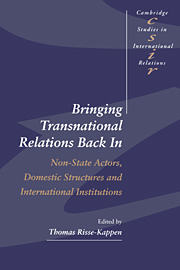 Bringing Transnational Relations Back In
Bringing Transnational Relations Back In Published online by Cambridge University Press: 02 December 2009
The chapters in this volume demonstrate that transnational relations matter in world politics and that we cannot explain state behavior in crucial issue-areas without taking the cross-boundary activities of non-state actors into account. Matthew Evangelista and Patricia Chilton illustrate, for example, that transnational relations contributed to the change in Soviet security policy and to the transformation processes in Eastern Europe and, thus, to the end of the Cold War. David Cameron argues that institutionalized transnational and trans-governmental actors were crucial in the negotiations leading to the treaty on European Economic and Monetary Union (EMU) which is supposed to institute a common currency in Europe by the end of the decade.
But the chapters in this volume also show that there are important limits to the impact of even powerful transnational actors. Cal Clark and Steve Chan show that the contribution of multinational corporations (MNCs) to economic growth in East Asia depends on state strength in conjunction with a Confucian culture. Peter Katzenstein and Yutaka Tsujinaka demonstrate that American MNCs needed support from the US state in order to penetrate Japanese markets. Matthew Evangelista shows that the impact of US-Russian transnational coalitions on Russian arms control policy decreased when the country's domestic structure changed. Thomas Princen argues that the success of environmental International Non-Governmental Organizations (INGOs) might sometimes be counter-productive for their goals, if they neglect the domestic conditions in their “target states.” In sum, this volume does not confirm some arguments of the earlier debate on transnational relations that interdependence among societies is becoming all-pervasive thereby diminishing the role of the state in international relations.
To save this book to your Kindle, first ensure [email protected] is added to your Approved Personal Document E-mail List under your Personal Document Settings on the Manage Your Content and Devices page of your Amazon account. Then enter the ‘name’ part of your Kindle email address below. Find out more about saving to your Kindle.
Note you can select to save to either the @free.kindle.com or @kindle.com variations. ‘@free.kindle.com’ emails are free but can only be saved to your device when it is connected to wi-fi. ‘@kindle.com’ emails can be delivered even when you are not connected to wi-fi, but note that service fees apply.
Find out more about the Kindle Personal Document Service.
To save content items to your account, please confirm that you agree to abide by our usage policies. If this is the first time you use this feature, you will be asked to authorise Cambridge Core to connect with your account. Find out more about saving content to Dropbox.
To save content items to your account, please confirm that you agree to abide by our usage policies. If this is the first time you use this feature, you will be asked to authorise Cambridge Core to connect with your account. Find out more about saving content to Google Drive.